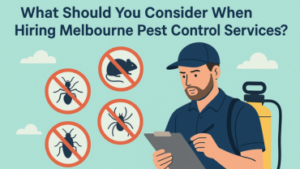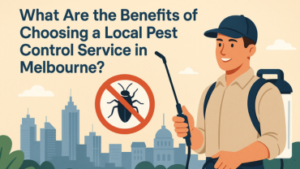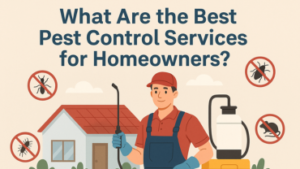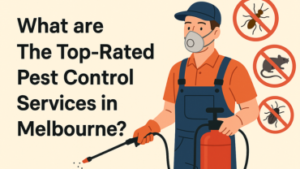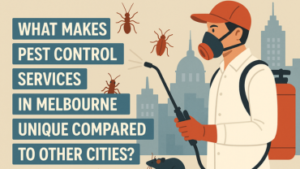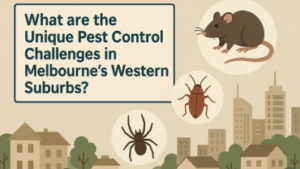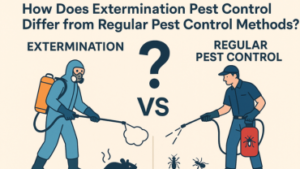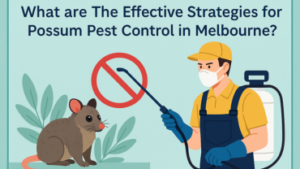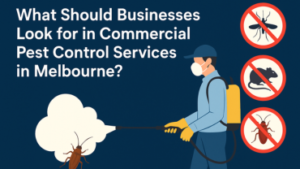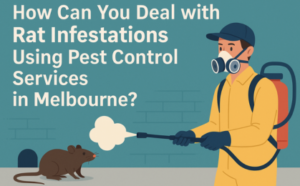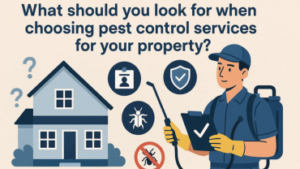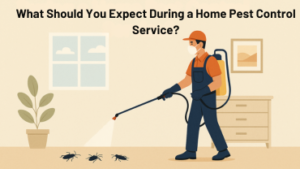1. Initial Inspection: The First Line of Defence
Before any treatment begins, a thorough inspection is crucial. A professional pest controller will:- Walk through your home, checking common hotspots like kitchens, bathrooms, basements, and gardens.
- Identify the type of pests (cockroaches, spiders, rodents, termites, etc.) and the extent of the infestation.
- Look for entry points, nests, and breeding grounds.
2. Customised Treatment Plan: One Size Doesn’t Fit All
Not all pest problems are the same. A cookie-cutter approach won’t cut it. After the inspection, your technician will discuss:- The best treatment methods (sprays, baits, traps, or eco-friendly solutions).
- Areas that need immediate attention (e.g., ant trails in the kitchen or termite damage in the walls).
- Preventative measures to stop future invasions.
3. The Actual Treatment: Fast, Effective, and Safe
Now comes the action phase. Depending on the infestation, the technician may:- Apply targeted sprays or gels in high-activity zones.
- Set up bait stations for rodents or cockroaches.
- Use dust treatments in wall voids or crawl spaces.
- Seal entry points to block future pest access.
4. Post-Treatment Guidance: Keeping Pests Away for Good
A good pest control at home service doesn’t end with the treatment. Your technician will provide tips like:- Cleaning routines to deter pests (e.g., sealing food, fixing leaks).
- Signs to watch for (e.g., droppings, gnaw marks).
- Follow-up visits if needed (some pests, like termites, require ongoing monitoring).
5. Peace of Mind: The Ultimate Goal
The best part? You can relax knowing your home is pest-free. No more midnight scuttles or surprise encounters in the pantry. Just a clean, safe living space. At Chris Pest Control, we take pride in delivering Professional home pest control services across Australia. Our experts are trained, licensed, and committed to solving your pest problems, permanently.Why Professional Pest Control at Home is Worth Every Penny
Trying to handle pests yourself might seem cost-effective, until the infestation comes back worse than before. Professional pest control at home services offer:- Targeted solutions – Experts identify the root cause rather than just treating symptoms.
- Long-term savings – DIY fails often lead to repeated spending on store-bought traps and sprays.
- Time efficiency – No more wasted weekends battling ants or setting mousetraps.
- Guaranteed results – Reputable companies like ours stand by our work with follow-up support.
How Often Should You Schedule Pest Control at Home?
The frequency depends on your situation:- Heavy infestations may require monthly treatments initially.
- Preventative maintenance typically works best with quarterly visits.
- Seasonal peaks (summer for flies, winter for rodents) may need extra attention.
The Truth About DIY vs. Professional Pest Control at Home
Let’s be honest, when you spot a cockroach scuttling across your kitchen floor or notice ants marching through your pantry, your first instinct might be to grab a can of bug spray from the supermarket. DIY pest control seems cheaper, quicker, and more convenient. But does it actually work? And when should you call in the professionals? Here’s the real breakdown of DIY vs. professional pest control at home, so you can make the best choice for your situation.The DIY Approach: Pros and Cons
Pros:-
✔ Immediate Action – You can tackle the problem right away without waiting for an appointment.
✔ Lower Upfront Cost – A can of spray or a pack of traps might only set you back $20.
✔ Familiarity – You know your home better than anyone and can target visible pests.
-
✖ Surface-Level Fixes – DIY methods often only kill the pests you see, not the nests or colonies hiding in walls.
✖ Misidentification Risk – Using ant spray on termites (or vice versa) wastes time and money.
✖ Safety Hazards – Overusing store-bought chemicals can expose your family and pets to toxins.
✖ False Sense of Security – Pests often return stronger because the root cause wasn’t addressed.
Professional Pest Control at Home: Why It’s Worth It
What the Pros Do Differently:-
✔ Accurate Identification – Experts know the difference between a German cockroach and a common black ant, and how to treat each.
✔ Targeted Treatments – They use the right chemicals (or eco-friendly alternatives) in the right places, minimising risk.
✔ Prevention Focus – Instead of just killing pests, they block future entry points and breeding grounds.
✔ Guaranteed Results – Most reputable companies (like us!) offer warranties—if pests come back, so do they.
Common Misconceptions:
-
✖ “It’s too expensive.” – Actually, preventing an infestation is cheaper than emergency extermination later.
✖ “The chemicals are dangerous.” – Professionals use regulated, low-toxicity products applied precisely where needed.
✖ “I can do the same thing myself.” – Without training, you might make the problem worse (e.g., spraying a wasp nest and getting stung).
Safety First: Is Pest Control at Home Safe for Kids and Pets?
We get it, chemicals sound scary. Here’s how we ensure safety:- Pet- and child-friendly products – Modern treatments break down quickly after application.
- Precise application – Targeting cracks and crevices minimises exposure.
- Clear instructions – We’ll tell you when to vacate areas and when it’s safe to return.
Seasonal Considerations for Pest Control at Home
Australia’s extreme weather shifts make pests a year-round problem, but your defence strategy should change with the seasons. Here’s what to expect:Summer (Peak Invasion Season)
- Flies and mosquitoes thrive in humidity
- Ant colonies expand rapidly seeking water
- Spiders become more active (hello, funnel webs!)
- Our treatment focus: Barrier sprays, fly traps, and eliminating standing water
Autumn (Sneak Attack Season)
- Rodents seek shelter as temperatures drop
- Cockroaches migrate indoors
- Termites begin swarming in northern states
- Our treatment focus: Baiting systems, crack sealing, and termite inspections
Winter (Silent Infestation Season)
- Rats and mice tunnel into wall cavities
- Bed bugs spread via heating ducts
- Silverfish damage stored winter clothing
- Our treatment focus: Rodent proofing, heat treatments, and wardrobe protection
Spring (Breeding Boom Season)
- Wasps and bees establish new nests
- Garden pests like aphids multiply
- Flea eggs hatch en masse
- Our treatment focus: Nest removal, garden-safe sprays, and flea bombs
What to Do Before and After Pest Control at Home
Before:
- Declutter (especially floors and countertops).
- Store food in airtight containers.
- Secure pets in another room.
After:
- Wait the recommended time before cleaning treated areas.
- Fix leaky taps, pests love moisture.
- Report any follow-up concerns within the guarantee period.
5 Red Flags You Need Immediate Pest Control at Home
- Mysterious bites or rashes – Bed bugs or mites might be throwing a party in your sheets.
- Odd smells or sounds – Rodents in walls often squeak or leave musky odours.
- Sawdust-like piles – Termites literally eat you out of house and home.
- Grease marks on walls – Cockroaches leave dark trails along their regular routes.
- Sudden ant highways – A few scouts today mean an army tomorrow.
How to Choose the Right Pest Control at Home Provider
Not all pest controllers are created equal. Here’s what separates the pros from the cowboys:Green Flags (Look for These)
- Licensing: Legitimate technicians carry state-issued pest management licenses
- Insurance: $10M+ public liability coverage protects your property
- Guarantees: Written promises to return if pests persist (we offer 12-month warranties)
- Transparent Pricing: Upfront quotes with no hidden charges
- Local Knowledge: Understanding of regional pest patterns (essential in Australia!)
Ready to Reclaim Your Home?
Pests don’t stand a chance when you call the pros. If you’re tired of sharing your space with unwanted guests, it’s time to take action. Contact Chris Pest Control today for a thorough inspection and a pest-free home tomorrow. Let’s make those pests history, for good![Get Quote Now]

